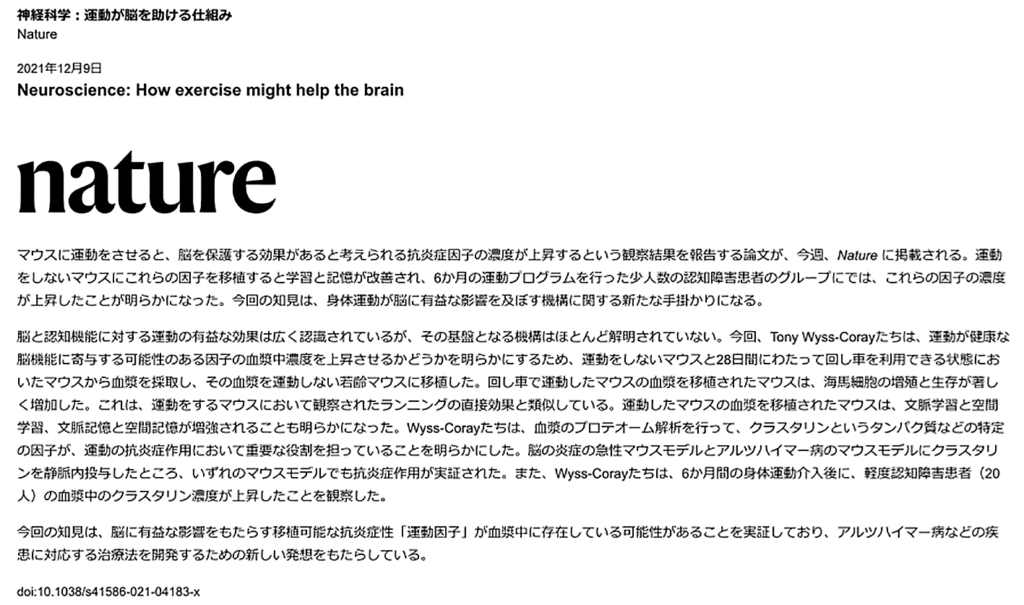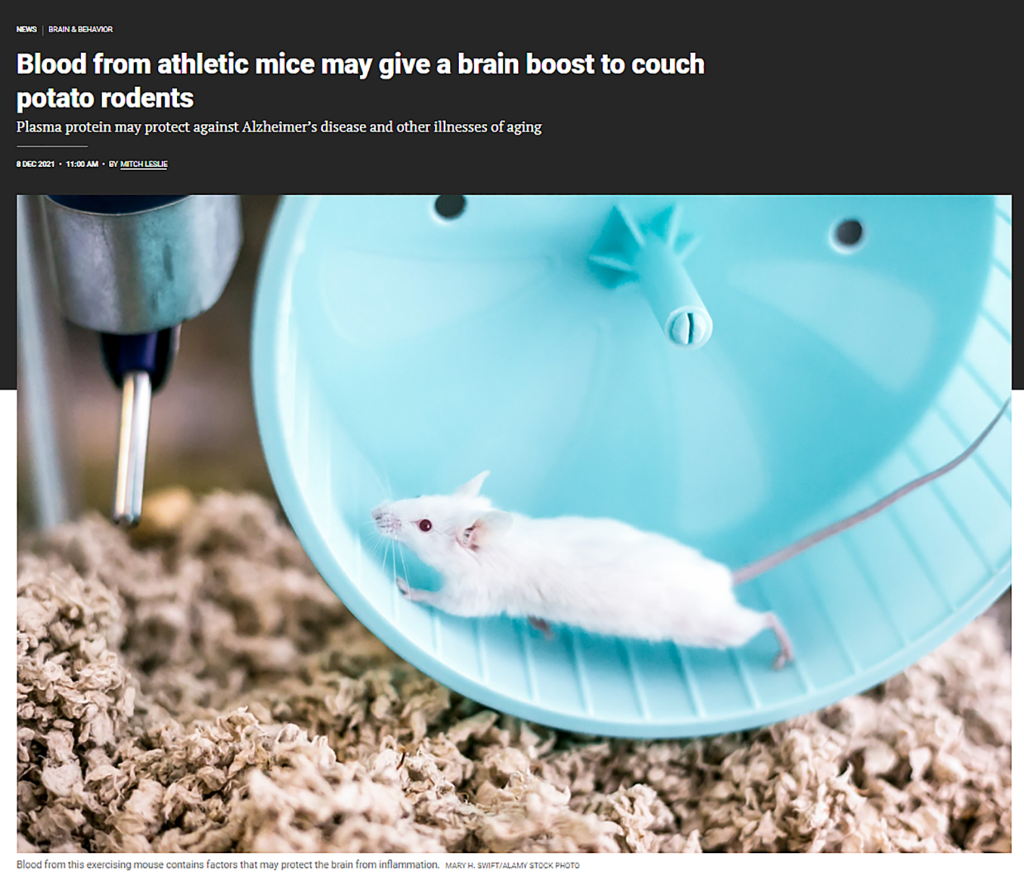Nature Article Volume 600, pages494–499 (2021)
Published: 08 December 2021
Exercise plasma boosts memory and dampens brain inflammation via clusterin (運動しているマウスの血漿はクラスタリン(CLU)を介して記憶力を高め、脳の炎症を和らげる)
Zurine De Miguel, Nathalie Khoury, Michael J. Betley, Benoit Lehallier, Drew Willoughby, Niclas Olsson, Andrew C. Yang, Oliver Hahn, Nannan Lu, Ryan T. Vest, Liana N. Bonanno, Lakshmi Yerra, Lichao Zhang, Nay Lui Saw, J. Kaci Fairchild, Davis Lee, Hui Zhang, Patrick L. McAlpine, Kévin Contrepois, Mehrdad Shamloo, Joshua E. Elias, Thomas A. Rando & Tony Wyss-Coray
Department of Neurology and Neurological Sciences, Stanford University School of Medicine, Stanford, CA, USA
Glenn Center for the Biology of Aging, Stanford University School of Medicine, Stanford, CA, USA
Wu Tsai Neurosciences Institute, Stanford University, Stanford, CA, USA
〇Abstract
Physical exercise is generally beneficial to all aspects of human and animal health, slowing cognitive ageing and neurodegeneration1. The cognitive benefits of physical exercise are tied to an increased plasticity and reduced inflammation within the hippocampus2,3,4, yet little is known about the factors and mechanisms that mediate these effects. Here we show that ‘runner plasma’, collected from voluntarily running mice and infused into sedentary mice, reduces baseline neuroinflammatory gene expression and experimentally induced brain inflammation. Plasma proteomic analysis revealed a concerted increase in complement cascade inhibitors including clusterin (CLU). Intravenously injected CLU binds to brain endothelial cells and reduces neuroinflammatory gene expression in a mouse model of acute brain inflammation and a mouse model of Alzheimer’s disease. Patients with cognitive impairment who participated in structured exercise for 6 months had higher plasma levels of CLU. These findings demonstrate the existence of anti-inflammatory exercise factors that are transferrable, target the cerebrovasculature and benefit the brain, and are present in humans who engage in exercise.
運動は、認知機能の老化や神経変性を遅らせるなど、人や動物の健康のあらゆる面で有益である1。運動による認知機能の向上は、海馬2,3,4における可塑性の向上と炎症の抑制に関連しているが、これらの効果を媒介する因子やメカニズムについてはほとんど知られていない。今回、私たちは、自発的に走っているマウスから採取した「ランナー血漿」を、座りがちなマウスに注入することで、ベースラインの神経炎症遺伝子の発現が減少し、実験的に誘発された脳の炎症が抑制されることを示した。また、血漿中のプロテオミクス解析により、クラスタリン(CLU)を含む補体カスケード阻害物質が協調して増加することが明らかになった。CLUを静脈内注射したところ、脳内皮細胞に結合し、急性脳炎症モデルマウスおよびアルツハイマー病モデルマウスの神経炎症遺伝子発現を低下させることがわかった。また、体系的な運動に6ヵ月間参加した認知機能障害患者は、血漿中のCLU濃度が高かった。これらの知見は、脳血管系を標的とし、脳に恩恵をもたらす、移植可能な抗炎症性運動因子が、運動を行うヒトに存在することを示している。
〇Main
Physical activity evokes profound physiological responses in multiple tissues across the animal kingdom and is accepted to broadly improve human health1,5. The benefits of exercise extend to patients with neurodegeneration and brain trauma6,7, possibly by reducing neuroinflammation2. Long-term voluntary exercise in mouse models of Alzheimer’s disease (AD) and related disorders improve learning and memory, and decrease neuroinflammation3,7,8. How exercise exerts these beneficialeffects is poorly understood. It has been proposed that ‘exercise factors’—secreted from muscle and other tissues into the blood—subsequently signal to the brain. Factors including IGF-1 (ref. 9), VEGF10 and PF4 (ref.11) increase hippocampal neurogenesis in young mice, whereas GPDL1 rescues the age-related loss in neurogenesis and cognition in old mice12 (Extended Data Table 1). However, it is unknown whether exercise-conditioned plasma contains factors that benefit the young healthy brain, whether these factors are directly transferrable through the plasma, whether such factors mediate the anti-inflammatory effect of exercise and what the key factors are.
運動は、動物界全体の様々な組織に深い生理的反応をもたらし、ヒトの健康を幅広く改善すると認められている1,5。運動の効果は神経変性や脳外傷の患者にも及び6,7、おそらく神経炎症を軽減することが期待されている2。アルツハイマー病(AD)やその関連疾患のモデルマウスでは、長期間の自発的な運動により、学習や記憶が改善され、神経炎症が減少する3,7,8。しかし、運動がどのようにしてこれらの有益な効果をもたらすのかはよくわかっていない。筋肉などの組織から血液中に分泌される「運動因子」が、その後、脳にシグナルを送るのではないかと考えられている。IGF-1(インスリン様成長因子1、参考文献9)、VEGF10(血管内皮細胞増殖因子)、PF4(血小板第4因子、参考文献11)などの因子は、若いマウスでは海馬の神経新生を増加させ、老齢マウスではGPDL1が加齢に伴う神経新生と認知機能の低下を回復させる12(補足データ表1)。しかし、運動条件付き血漿には、若くて健康な脳に利益をもたらす因子が含まれているのか、これらの因子は血漿を介して直接伝達されるのか、そのような因子が運動の抗炎症効果を媒介するのか、そしてその鍵となる因子は何なのかは不明である。

〇解説記事
Blood from athletic mice may give a brain boost to couch potato rodents (運動するマウスの血液は、怠け者の脳の力をアップする可能性がある)
Plasma protein may protect against Alzheimer’s disease and other illnesses of aging

